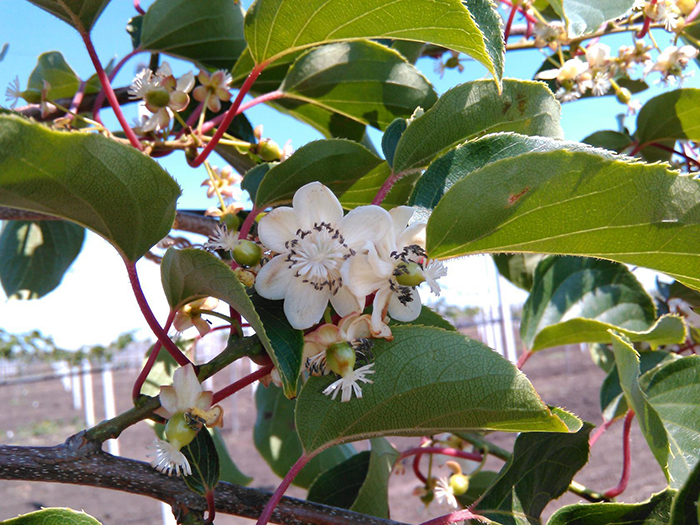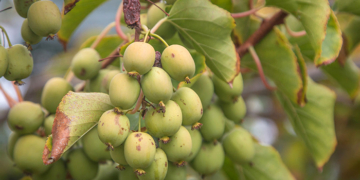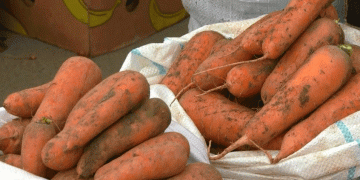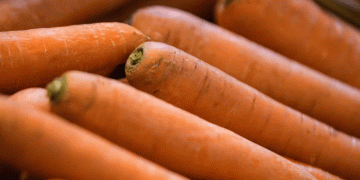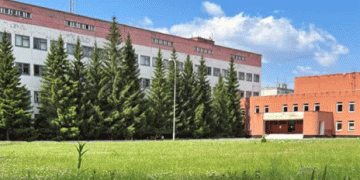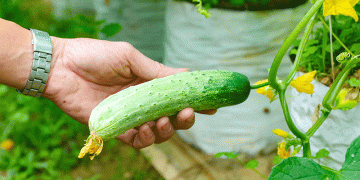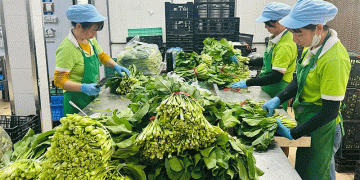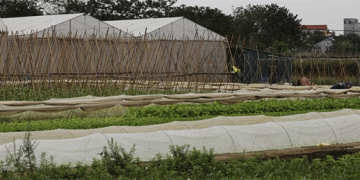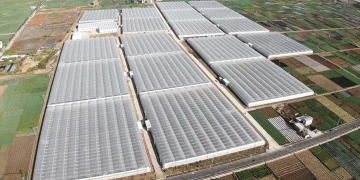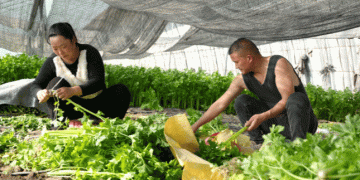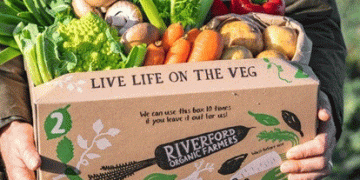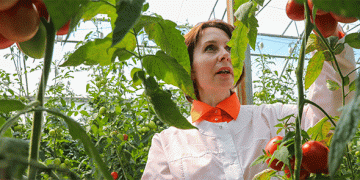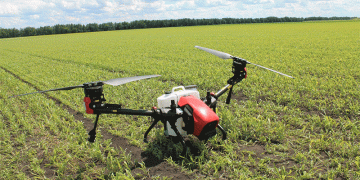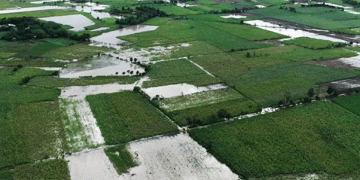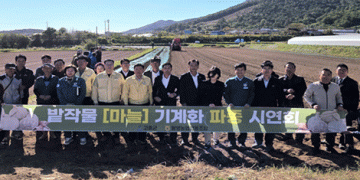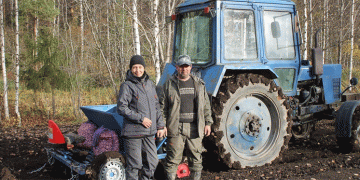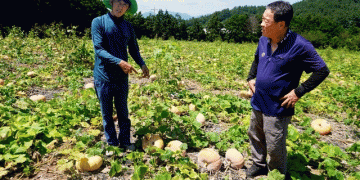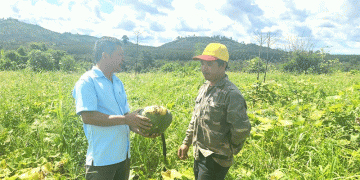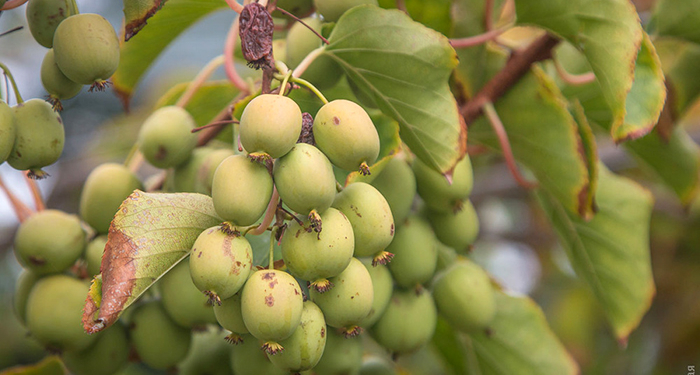To expand the range of fruits should be introduced into the production of crops that are considered uncommon. For example, such as actinidia, which is cultivated in Asian countries for many centuries. Due to the fragile structure of its fruits and the limited shelf life of actinidia berries have not yet become the subject of mass industrial cultivation, but recently the situation, including in Ukraine, is beginning to change. Actinidia is increasingly of interest not only to amateurs but also to professional horticultural farms.
So, a few years ago, knowing about the favorable weather conditions in Ukraine, the French company Primland decided to establish the production of actinidia trade brand Nergi, which belongs to the species Actinidia arguta in Ukraine, namely in Bilyaiv district of Odessa region on the lands of Black Sea Alliance. The first test crop of Ukrainian actinidia berries was harvested in 2015 – three years after planting, and in 2016, actinidia fruits could already be purchased in Ukrainian supermarkets. Ukrainian products were presented by Primland Director Francois Lafitte, who is an investor in the plantation. He said that such gardens are growing successfully in France and some other countries in southern Western Europe. The producers of the Nergi brand are mostly young people who prefer family farming. The average Nergi garden usually occupies limited plots of land, no more than 1 hectare. And actinidia plantations in Bilyaiv district of Odessa region are located on an area of 23.50 hectares. By the way, this is the first industrial actinidia plantation to appear in Ukraine.
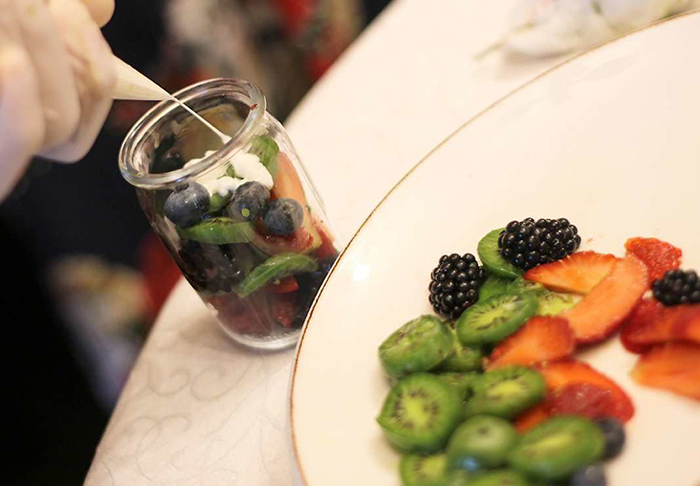
Actinidia from the Nergi brand is a small berry that resembles a kiwi, but is many times smaller in size, so it is also called a baby kiwi. It can be eaten without peeling. The crop is harvested by hand from August to mid-September. Berries contain a large number of vitamins. One plant gives from 10 to 50 kg of berries a year. Actinidia blooms in mid-May. There are male and female plants. The berries grow in clusters throughout the summer. The plant has the form of a vine, the length of which can reach 6 meters, the leaves have few.

HISTORY OF THE VARIETY
The New Zealand Research Center has bred new Actinidia arguta by natural selection, combining them under the Nergi brand. During his trip to New Zealand, Primland director Francois Lafitte was struck by this little berry. In September 2016, with the support of the Business France Agency, a presentation of new varieties of actinidia was held in Kyiv, which Ukrainian gardeners have recently started growing in partnership with the French company Primland.
In 2017–2020, the Department of Horticulture, Viticulture, Biology and Chemistry of Odessa State Agrarian University conducted research on varieties of actinidia. The experimental base was the planting of actinidia in LLC “Black Sea Alliance”. The results of the experiments showed that in the conditions of the South-Western Black Sea Coast of Ukraine and similar climatic conditions of actinidia cultivation is economically viable, using the developed technology of planting and growing plantations. The production of actinidia TM Nergi is based on strict specifications used in the garden, at the packaging site and during shipment.
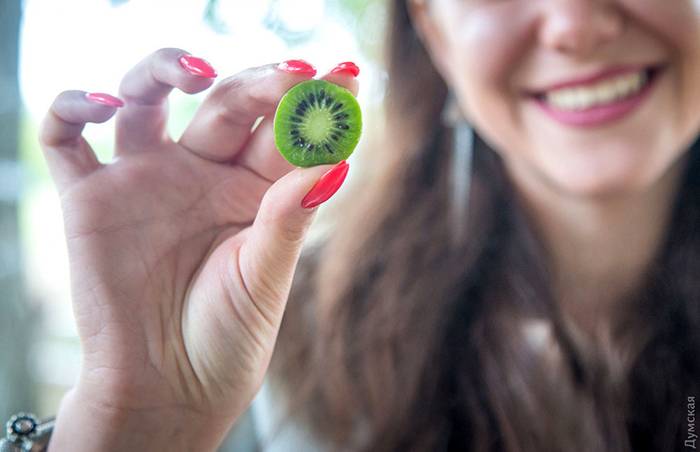
ELEMENTS OF TECHNOLOGICAL PROCESS
The scheme of planting actinidia on the lands of LLC “Black Sea Alliance” was at the rate of 5 x 4 m. The plantation has wallpaper and supports. The actinidia plantation is divided into two cells. In the first cell on the area of 8.25 ha and in the second cell on the area of 6.12 ha the cultivar of actinidia Tahi is grown, and in the second cell on the area of 2.1 ha the cultivar Isai is grown. The seedlings were purchased from the French nursery “Sofuruileg SL”. The purchase of imported seedlings has been agreed with the Ministry of Agrarian Policy and Food of Ukraine.
The temperature regime of the area is favorable for growing actinidia in the open ground: the sum of temperatures above 10 ° С – 4000–5000 ° С, the duration of the frost-free period – 220–290 days, the absolute long-term minimum – up to minus 15 ° С. In addition to Odesa, actinidia can be grown in Zakarpattia, Mykolaiv and Zaporizhia oblasts, where the sum of temperatures above 10 ° С reaches 3000–3400 ° С, and the frost-free period – 188–196 days, the absolute minimum – minus 15–18 ° С. Normal development of actinidia and at air temperatures up to + 25 ° C. Some new varieties are able to withstand rising temperatures during the growing season to + 35 ° C and frost to -17 ° C during dormancy.
Pesticide treatments have not been applied because the plants are not yet damaged by diseases and pests.

In young and adult age, actinidia plants tolerate shading of trees well, but for normal fruiting need sunlight, grow well in open lighted areas.
Special requirements for soil conditions in actinidia – optimal pH in the range of 4.5-5.5, high controllability; sufficient supply of moisture and batteries at a ratio of N: P: K – 1: 2: 1; plants react negatively to the increased content of carbonates. Actinidia grows best on loose, loamy, high-fertile, well-drained soils with sufficient moisture, does not tolerate flooding and reacts negatively to dry air. Moisture-loving is quite high, in non-irrigated conditions normal growth and fruiting with an annual rainfall of at least 800-1000 mm.
The plants finish growing in time by autumn, the wood of the shoots ripens well, which increases their winter hardiness. One- and two-year plants should be covered with leaves for the winter.
Pre-planting soil preparation, soil retention system before the plantations come into fruition
The technology provides a one-time deep pre-plantation loosening of the soil, which contributes to the loosening of compacted soil, as well as crushing and destruction of root residues.
For planting, plowing to a depth of 40 cm is required in such a way that planting is carried out not earlier than 2-3 months. After raising the plantation, the soil must be covered diagonally 2 times. Before dividing the area for planting the soil is leveled, cultivated and rolled.
In the area for actinidia, the soil is plowed to a depth of 25–30 cm with preliminary application of 60–80 t / ha of organic fertilizers and 60 kg / ha of phosphorus and potassium or fertilizers are applied to the pit during planting.
Construction of wallpaper and protective mesh
Actinidia is grown on supports, rows are formed according to the type of wallpaper “hedge”. Intermediate poles are installed at a distance of 8 meters and hang 5 tiers of wire, 6 wires. The first tier at a height of 30 cm for drip irrigation. The second tier is 60 cm high, the third tier is 90 cm high, the fourth tier is 130 cm high, and the fifth tier is 180 cm high. The fifth tier is paired. For a protective grid, a 5-meter reinforced concrete pole is installed every 8 meters.
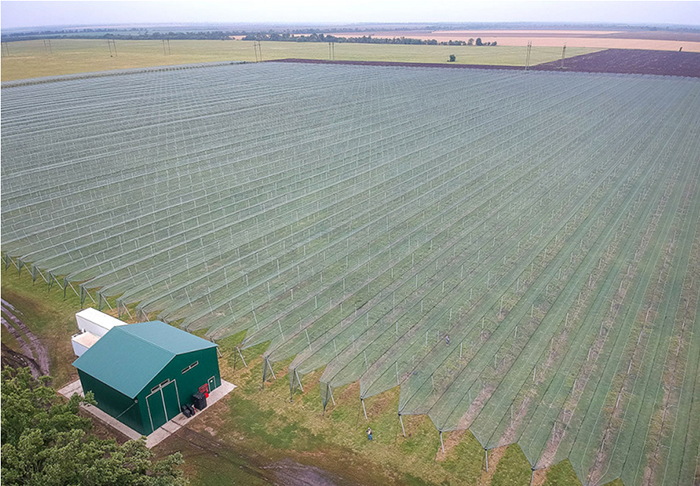
Soil maintenance and fertilizer application during the period of growing young plantations
The soil retention system is sidereal. The root system of actinidia is located in the surface layer of the soil, so in between rows sow green manure.
In the first year of the growing season, green manures (alfalfa – 4 kg / ha) are sown on the area of 17.20 ha, which are mowed twice from the 2nd year of the growing season without crushing and plowing.
To destroy weeds and loosen the soil in rows, there is a 5-time manual loosening of the stem strips.
Starting from the second year of vegetation – drip irrigation with a solution of mineral fertilizers (ammonium sulfate).
Vegetable crops can be planted between rows of young plantations. During the period of fruiting plants, the soil should be kept under clean steam and watered as it dries.
Fertilizers should be applied in the fall for digging. It should be borne in mind that the root system of actinidia is located superficially, so under the bushes you need to dig to a depth of 10-12 cm for every 0.01 ha once every two years make 2-3 quintals of manure or humus, and mineral fertilizers – annually : 1.5–2 kg of ammonium nitrate, 3–4 – superphosphate and 1–1.5 kg of potassium salt. With good plant growth, less fertilizer is applied.
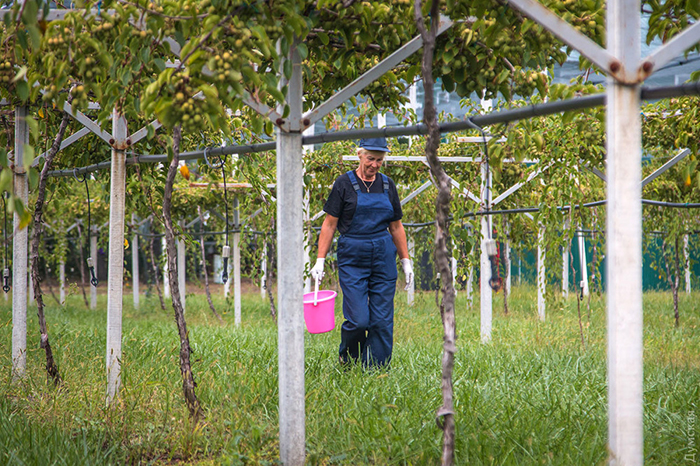
Planting and repair
Planting of actinidia on the soils of LLC “Black Sea Alliance” was carried out in the spring of 2012. After preparing the soil surface for planting, the area was divided into quarters and cages, and places for roads were marked. The site was manually divided into places with the help of a cord and two ropes with marks. With mechanized cultivation between rows of actinidia is better to plant with rows of 3-4 and 2-3 m in a row. Supports are needed to support the shoots. To do this, use grape-type wire wallpaper, to which the plants are tied so that the shoots are evenly distributed on the wallpaper. Its height should be at least 2 m from four rows of wire stretched on poles, the lower one is fixed at a height of 50-60 cm from the soil surface, the rest at equal distances from each other. When planting, the plants are cut into 3-4 buds, the sections are renewed, the broken ones are cut out, torn off and immersed in diluted clay.
Depth of planting hole 60 x 60 cm. In each hole during planting make fertile soil, 10-12 kg of humus, 100-200 g of superphosphate. You can make a mixture of sod and deciduous soil, sand and manure. After planting, the plants are watered, then the holes are mulched with peat, humus, fallen leaves or other organic residues.
Preparation of seedlings for planting was carried out on preparatory sites.
Before planting the seedlings, all damaged ends of the roots were cut to a healthy place. Damaged and rotten roots were cut out completely. After pruning, to prevent the roots from drying out during planting, they were soaked in a soil solution.
After all the preparatory work began planting. Seedlings were planted to a permanent place at the age of two.
Plants were planted in pits of 0.60 x 0.60 m. Immediately after planting, the seedlings were watered at the rate of 15 liters per plant. After planting, the seedlings were pruned to 3-4 buds.
When planting under each seedling was added absorbent “MahiMagin” 2 tablets, this operation increases soil productivity, accumulates moisture and nutrients, promotes their accumulation and rational consumption, improves water-air regime and physicochemical properties. Repair of plantings is planned in the first year within 5% of the seats. Repair of actinidia plantations by planting is most effective only on young plantations, so the repair was carried out in the autumn of the 1st year of vegetation in the amount of 5% of the planted seedlings.
Repair of actinidia plantations consists of planting plants in the place where they fell, replacing diseased and damaged seedlings.

Features of controlled bee pollination of actinidia commercial plantations
For pollination it is necessary to plant male and female plants alternately: one male and 10-15 females or one row of male plants and 5 rows of females.
Actinidia is a dioecious plant, therefore, female and male plants should be placed on the site. Female flowers in actinidia solitary or paired; males are placed on two – three in an inflorescence. Bloom at the same time, which provides good pollination. For fruiting on 5-10 plants with functionally female flowers, it is necessary to plant one plant with a male type of flowers. Each species of actinidia requires a suitable pollinator. Re-pollination between individual species does not occur. In addition, during the flowering period of actinidia, it is necessary to have 4-6 beehives per 1 ha of plantings with bees to ensure normal pollination.
Actinidia plants begin to bear fruit in the second or third year after planting. Laying and differentiation of generative buds occurs on the basis of one-year growth of different lengths in the early spring period, approximately 2 months before the onset of the phase of full flowering. The central part of the flower apex turns into a complex pistil with numerous columns, each of which has a separate open receptacle. Flowering lasts from late May to mid-June. According to the timing of flowering varieties are divided into 3 groups: 1) early; 2) average; 3) late flowering. Within the variety, flowering of pistil and stamen plants can occur simultaneously. Therefore, to ensure normal pollination, varieties of pistil and stamen plants that bloom at the same time are selected. Pollen is transferred to the pistil flowers by insects and wind.

Actinidia flowers emit a delicate and delicate aroma, they are perfectly pollinated by bumblebees and bees, but they are not honey bees, because they do not have nectaries. Bees use pollen from these flowers as protein food. The duration of flowering is ten to twelve days. At the same time, actinidia produces young shoots that grow up to two meters in summer. With the onset of autumn, the growth of lianas stops, and buds are formed on the shoots. Fruits in actinidia are full of juice, have a sweet and rich taste. An interesting feature of actinidia fruits is that they change their aroma from year to year. Sometimes the berries smell like pineapple, sometimes – apple. The plantation has an apiary for 120 bee colonies, which are used to pollinate actinidia flowers during flowering.
Ukraine is a state of gardens, with the flowering of which the pollination of agricultural crops begins. The apricot blooms first, then cherries, cherries. Almost simultaneously with them blooms plum, then pear, summer varieties of apple, and winter varieties complete its flowering. All species of fruit species, having bisexual flowers, are cross-pollinated. Some varieties of grain breeds can be pollinated with pollen of their own variety and give a small harvest. These varieties also bear fruit much better with cross-pollination. Self-pollination is prevented by the very structure of their flowers, different maturation dates of pistils and anthers. In addition, pollen from the same flower or a single variety from another tree does not give fertilization. The flower of the fruit breed is able to be fertilized only by pollen of the so-called pollinator variety. In horticulture, the best pollinators are known for certain varieties. This must be taken into account when laying gardens. In addition to the main variety, depending on the type of garden, plant different forms of pollinators. The results of pollination and yield of gardens largely depend on agrotechnology of horticulture, age of trees, intensity of flowering, weather conditions, especially during flowering, and pollination of bees. There are still few wild pollinating insects in this early spring period, and their role in pollination is insignificant. The main pollinators of gardens are honey bees. Without them, fruit trees do not form ovaries and after abundant flowering almost do not give the desired harvest. When the saturation of bees is high, intensive gardens form 30 – 40% of useful ovaries, and with abundant flowering ovary 2 – 3% of flowers provides a high yield. The flowers of some varieties have close anthers, which makes it difficult for bees to access nectar. These flowers are well pollinated by bees that collect pollen. In other varieties, access to nectar is free. Bees, collecting it, pollinate flowers less, and ovaries are formed less.
